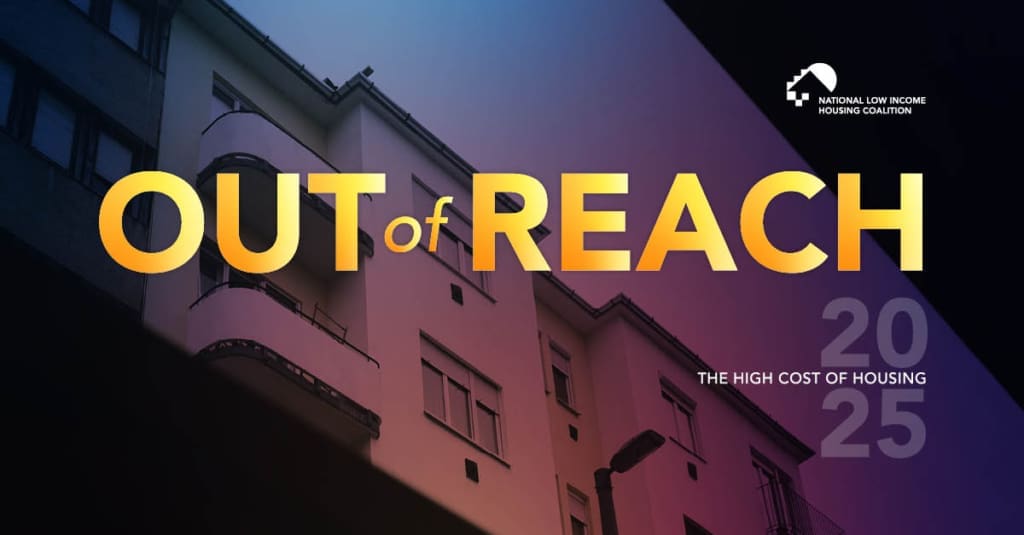Full-time workers need to earn $27.14 per hour to afford a modest, two-bedroom apartment at Fair Market Rent in North Carolina. This is North Carolina’s “2025 Housing Wage” according to Out of Reach, a report published today by the National Low Income Housing Coalition (NLIHC). In 2024, the state’s housing wage was $25.21.
Out of Reach, released annually, documents the gulf between wages and what people need to earn to afford their rents. The report routinely shows that affordable rental homes remain out of reach for millions of low-wage workers and their families. The report’s “Housing Wage” is an estimate of the hourly wage full-time workers must earn to afford a rental home at HUD’s Fair Market Rent without spending more than 30% of their incomes. In 2025, the national Housing Wage is $33.63 per hour for a modest two-bedroom rental home and $28.17 for a modest one-bedroom rental home.
“This report is a critical reminder that we cannot reduce the affordable housing crisis down to individual choice or supply alone. This report reminds us that wages are not keeping up with the cost of living and that more and more North Carolinians are experiencing the strain of cost-burden across our state. Making an even greater case for why we need solutions that address supply, stability, subsidy, and systems to address the true scale of the need.” -Stephanie Watkins-Cruz, Director of Housing Policy
Out of Reach 2025 reveals that, even when factoring in higher state and county-level minimum wages, the average minimum-wage worker in the U.S. must work 116 hours per week (2.9 full-time jobs) to afford a two-bedroom rental home at Fair Market Rent, or 97 hours per week (2.4 full-time jobs) to afford a one-bedroom rental home at Fair Market Rent. A full-time minimum-wage worker in only 7% of counties nationwide (none in NC) can afford a one-bedroom rental home at Fair Market Rent, and these counties are in states with a minimum wage higher than the federal minimum wage of $7.25 per hour—a wage that has remained unchanged since 2009 and is now a poverty level wage.
Yet higher minimum wages alone will not solve the housing affordability crisis: 64 counties and municipalities have minimum wages set higher than the federal or, where applicable, state minimum wage, but in each of these jurisdictions, the local minimum wage still falls short of the local one-bedroom and two-bedroom Housing Wages.
Working at the minimum wage of $7.25 in North Carolina, a wage earner must have 3.3 full-time jobs or work 131 hours per week to afford a modest one-bedroom apartment and have 3.7 full-time jobs or work 150 hours per week to afford a two-bedroom apartment. But the affordability crisis affects more than just minimum wage earners. Some common occupations in North Carolina like construction workers, retail salespeople, and nursing assistants provide a median wage lower than the wage needed to afford a modest one-bedroom apartment.
The report is filled with important data that highlights the gap between wages and cost of housing across every state, county, non-metropolitan area, and metropolitan area across the United States. In North Carolina’s most populous regions, the housing wage is even higher than the state Housing Wage of $27.14:
| Most Expensive Areas in NC | Housing Wage |
| Durham-Chapel Hill HMFA | $36.00 |
| Charlotte-Concord-Gastonia HMFA | $35.08 |
| Raleigh MSA | $33.90 |
| Virginia Beach-Norfolk-Newport News HMFA (includes northeast NC & part of the Outer Banks) |
$32.62 |
| Wilmington HMFA | $30.38 |
The affordable housing crisis isn’t limited to urban areas: a minimum wage worker living in rural NC would need to work on average more than 2.2 full-time jobs to afford a modest one-bedroom rental home.
Significant disparities between what renters earn and their housing costs leave their housing security especially precarious during periods of economic uncertainty. Out of Reach 2025 sheds light on how recent economic downturns have led to long-term increases in the prevalence of housing cost burdens among the lowest-income renters. Housing cost burdens prevent low-income renters from affording other basic necessities and also keep them at constant risk of housing instability.
Despite urgent housing affordability challenges and economic uncertainty, the future of federal housing assistance is at risk. Current federal budget proposals threaten significant cuts to housing assistance programs and the loss of thousands of housing vouchers. The president’s budget request for FY 2026 proposes a devastating 44% cut to HUD’s overall funding, which would eliminate rental assistance programs, consolidate five key programs into a single, restrictive State Rental Assistance Block Grant, and impose a two-year time limit on assistance. The Trump Administration is also expected to pursue harmful regulations that would make it more difficult for families to obtain and maintain HUD assistance, including burdensome work reporting requirements.
“Housing is more than just a shelter, it is foundational to well-being and dignity,” said NLIHC President and CEO Renee Willis. “This year’s Out of Reach report shows that, despite economic gains for some, low-income renters continue to face impossible choices between paying rent and meeting basic needs. Cutting federal housing investments would only deepen the housing crisis. Congress must protect and expand housing programs that ensure stability, opportunity, and a pathway out of poverty for millions of renters.”
We’ll continue to analyze the North Carolina OOR data over the next few weeks. For additional information and to download the report, visit: http://www.nlihc.org/oor








